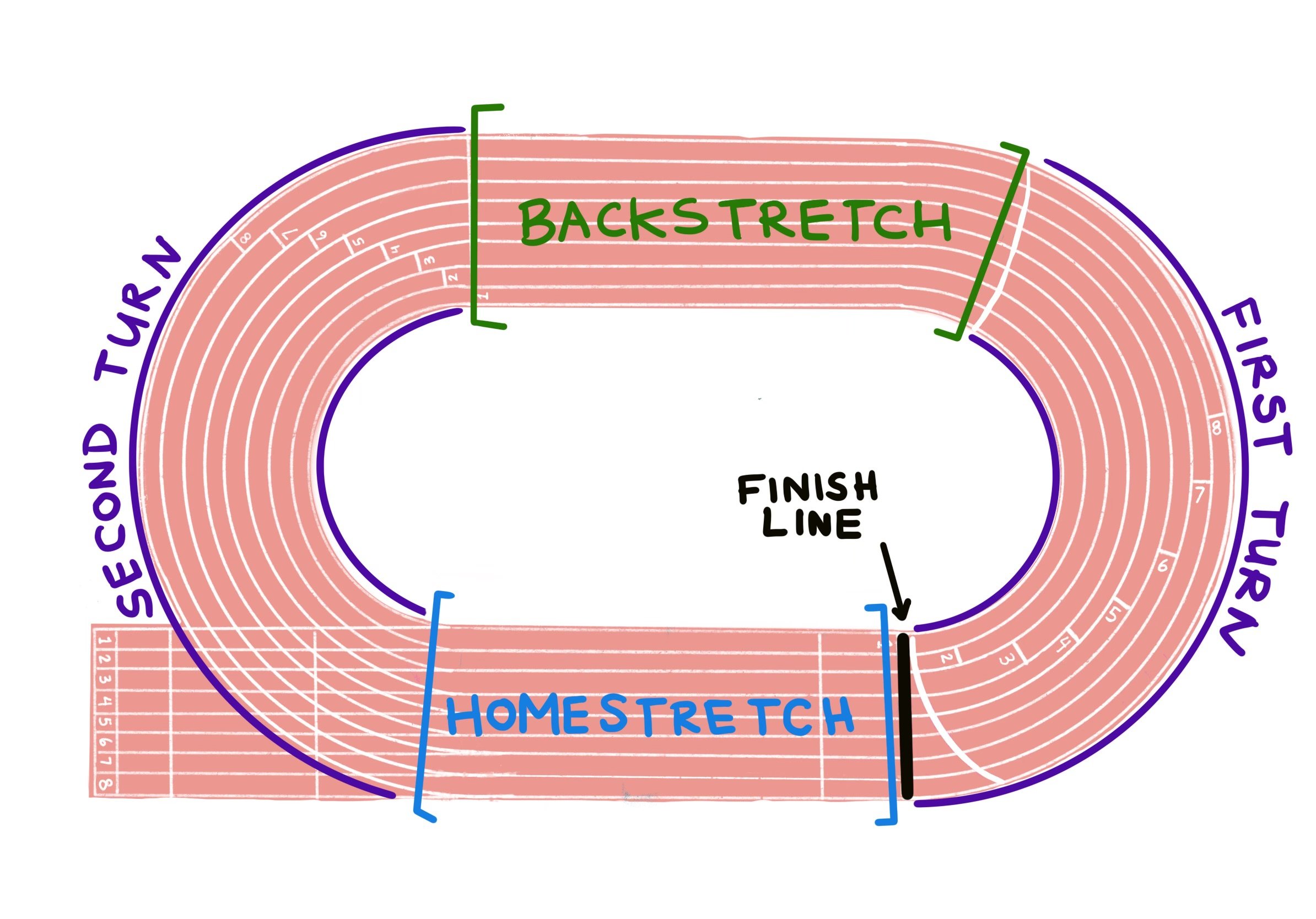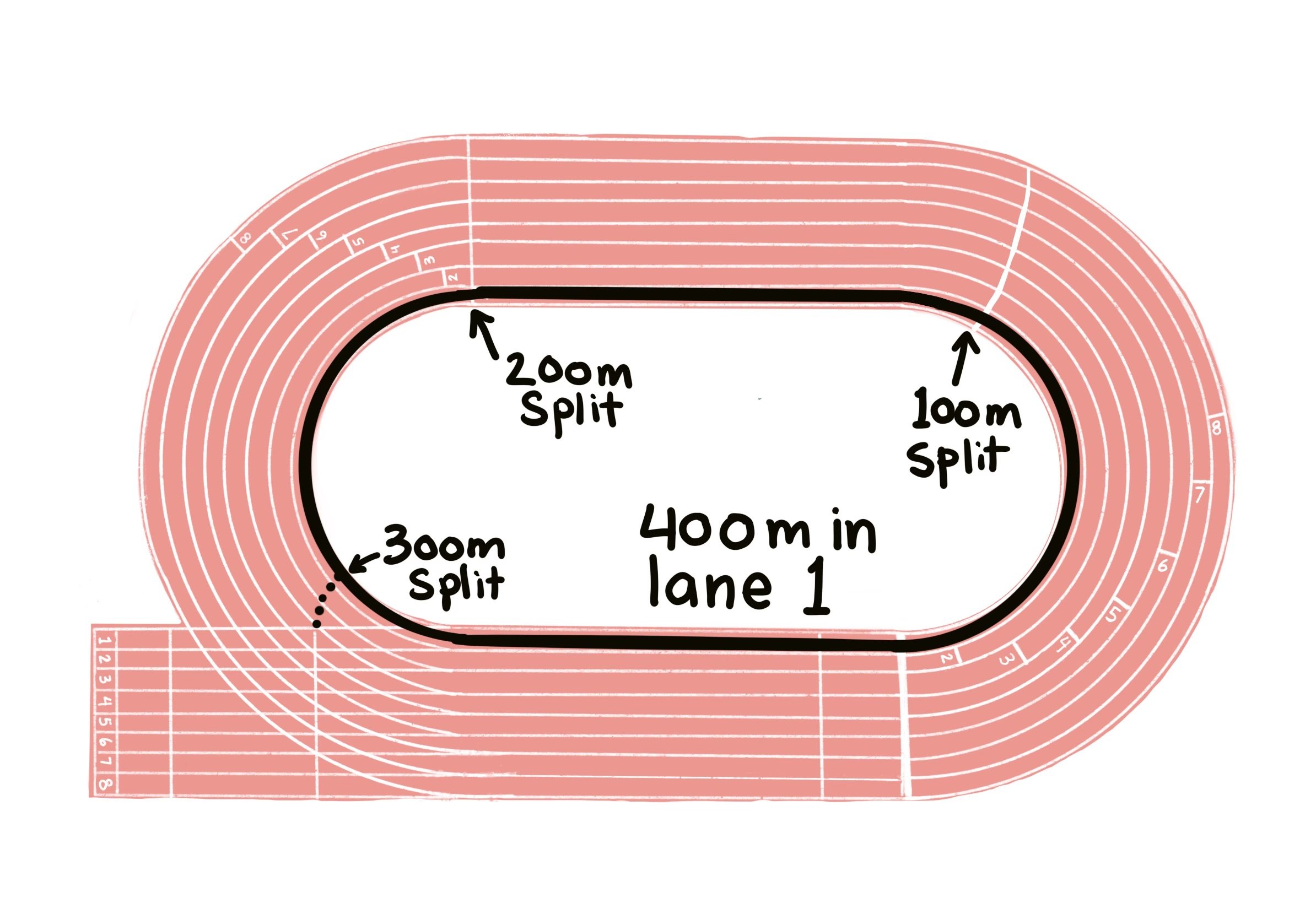Track Jargon: Waterfalls, Cut-in, Negative Splits & more
I want to end this mini-series on track running with some of my favourite recommended workouts, but first I need to explain some track jargon. The following terms will help anyone who wants to communicate regarding track interval workouts, time trials or races.
Homestretch
This is the straight stretch of track leading up to the finish line. Every runner should learn to pace themselves so they can run strong on the homestretch.
© copyright Sifuentes Coaching 2022
Backstretch
This is the straight stretch of track on the “far” side, away from the finish line.
1st Turn & 2nd Turn
As shown in the drawing, the first turn leads into the backstretch, and the second turn leads into the homestretch. When a runner exits the second turn and moves into the homestretch, it is referred to as “coming off the final bend.”
© copyright Sifuentes Coaching 2022
Stagger
The stagger is the distance between the common finish line and the start line in the outer lanes. In lane 1 there is no stagger because a runner will start at the common finish line. Notice that the stagger to the 400m start line is twice the distance as the stagger for the 200m start line. This is because the 200m only covers one turn (the 2nd turn) so the discrepancy in distance is less than for the 400m which covers both turns.
When runners are running at the same speed, they will be neck-and-neck as the enter the homestretch. If a runner is faster than the others, they will approach or overtake the runners in the lanes outside of their own lane while on the turn. This is referred to as “making up the stagger.” When there is a runner who makes up the stagger while on the turn, they will be clearly in the lead when the runners enter the homestretch.
Cut In
Cutting in refers to runners moving out of their assigned lane and into Lane 1. For races 400m and shorter there is no cutting in - all runners remain in their lanes from start to finish. For longer races, runners start in their lanes or in a waterfall start (explanation below) and cut in to lane 1 after the race starts.
For the 800m, runners start in lanes and cut in on the backstretch. For races longer than 800m, runners start on a waterfall and cut in immediately, or as soon is safe to do so (taking care not to trip other runners).
Waterfall Start
A waterfall start is used for races with more than 8 competitors and for all races longer than 800m. The runners line up on the curved start line and can cut in when it is safe to do so.
Splits
Splits are the times (in minutes or seconds) it takes cover intermediate distances along the way to a full interval distance. For example, if a runner covers 1 full lap (400m) in 2 minutes and maintains a steady pace, the runner will split 1 minute at halfway (200m).
Splits are important because they help us learn to pace appropriately. Runners should learn to measure their effort so they are able to finish strong. If a runner can maintain even splits, that means they are running a steady pace without slowing down or speeding up.
A runner maintaining a steady pace for 400m will split 30 seconds at 100m, 1minute through 200m, 1:30 at 300m and 2 minutes for the full lap.
© copyright Sifuentes Coaching 2022
If a runner covers 400m in 2 minutes and their 200m split is 1 minute, we know that this runner ran a steady, even pace. If the runner covers 400m in 2 minutes but their 200m split was 40 seconds, we know that the runner needed 1:20 minute to cover the second 200m - in other words the runner slowed down a lot.
Negative Splits
When a runner speeds up in the second half of an interval or a race it is called negative splitting. For example: a runner who covers 400m in 2 minutes and splits 1:10 min at 200m has executed a negative split.
Negative splits indicate that a runner has the ability to pace themselves and finish with an extra burst of effort. A very significant negative split indicates that a runner may have started too conservatively and ran very easy and comfortable at the start of the interval or race.
Even splitting is the most energy efficient way to run, with the most even distribution of effort throughout an interval. I should note, however, that due to accumulation of fatigue the final 100m (from 300 to 400m) in 30seconds would require more effort than the first 100m in 30 seconds.
Runners taking their own splits during an interval workout
Positive splits (slowing down throughout an interval) indicate that a runner started out too fast or or does not know how to push through the discomfort of fatigue.
Splits in Workouts
Taking splits during workout intervals is a helpful way to learn how to pace ourselves. A coach can provide splits to a runner on the track if the coach has a stopwatch. A runner can also take their own splits using a basic digital wristwatch.
A simple digital watch with a split button is one of the most useful tools for a runner who wants to do track workouts. Read more about my recommendations in Garmin Vs Apple Watch.
ON THURSDAY
Some of my favourite interval track workouts! Stay tuned!
Nicole Sifuentes is a full-time Running Coach for adults of all ages and abilities. She is a former professional runner and 2-time Olympian, and Certified Strength and Conditioning Specialist. Read more about her services, and schedule your free coaching consultation.




